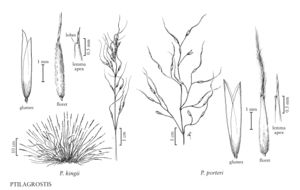Difference between revisions of "Ptilagrostis kingii"
Common names: King's ptilagrostis Sierra ptilagrostis
Synonyms: Oryzopsis kingii unknown
Treatment appears in FNA Volume 24. Treatment on page 143.
FNA>Volume Importer |
FNA>Volume Importer |
||
| Line 20: | Line 20: | ||
-->{{Treatment/Body | -->{{Treatment/Body | ||
|distribution=Calif. | |distribution=Calif. | ||
| − | |discussion=<p>Ptilagrostis kingii grows along damp streambanks and wet meadows of the Sierra Nevada, at elevations from 2700-3500 m. It differs from most species in the genus in its scabridulous, rather than plumose, awns and short lemma lobes.</p> | + | |discussion=<p><i>Ptilagrostis kingii</i> grows along damp streambanks and wet meadows of the Sierra <i>Nevada</i>, at elevations from 2700-3500 m. It differs from most species in the genus in its scabridulous, rather than plumose, awns and short lemma lobes.</p> |
|tables= | |tables= | ||
|references= | |references= | ||
| Line 41: | Line 41: | ||
|publication year= | |publication year= | ||
|special status= | |special status= | ||
| − | |source xml=https://jpend@bitbucket.org/aafc-mbb/fna-data-curation.git/src/ | + | |source xml=https://jpend@bitbucket.org/aafc-mbb/fna-data-curation.git/src/8f726806613d60c220dc4493de13607dd3150896/coarse_grained_fna_xml/V24/V24_193.xml |
|subfamily=Poaceae subfam. Pooideae | |subfamily=Poaceae subfam. Pooideae | ||
|tribe=Poaceae tribe Stipeae | |tribe=Poaceae tribe Stipeae | ||
Revision as of 17:18, 18 September 2019
Culms 15-38 cm tall, 0.4-0.8 mm thick. Basal ligules 1-2 mm, acute; upper ligules to 2.5 mm; blades filiform, about 0.3 mm in diameter. Panicles 6-10 cm, loosely contracted; branches ascending to appressed. Glumes 3-4.5 mm; florets 2.8-4.2 mm; calluses 0.3-0.7 mm; lemmas with 0.1-0.4 mm lobes; awns 10-14 mm, scabridulous, not hairy, weakly once- or twice-geniculate; anthers 0.5-1.5 mm, penicillate. Caryopses 1.5-2.3 mm. 2n = 11.
Discussion
Ptilagrostis kingii grows along damp streambanks and wet meadows of the Sierra Nevada, at elevations from 2700-3500 m. It differs from most species in the genus in its scabridulous, rather than plumose, awns and short lemma lobes.
Selected References
None.
Lower Taxa
None.
